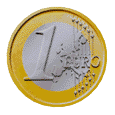


 |
The History of the
European Union and the Euro
During the time of the Roman Empire, Europe had a united government, a common language (Latin), a system of international laws and a common currency. These are things that that the European Union is working towards at present. On the first of January 2002, Europe will share a currency for the first time in almost 1,500 years- the Euro.
In 1946 Winston Churchill, the British Prime Minister, said
"We must re-create the European family...called the United States of Europe, France and Germany must take the lead...Great Britain, the Commonwealth, mighty America, and I trust, the Soviet Union must be friends and sponsors of the New Europe.1948- Benelux Belgium, the Netherlands and Luxembourg joined together to set up a free trade area where goods could mover freely without the restrictions of taxes.
1949- The Council of Europe A number of European states including France, Italy and the Benelux countries met and formed a council of Europe. 'The aim of a Council of Europe is provide greater unity between its members...
18 April 1951- The Treaty of Paris Two leading French statesmen, Robert Schuman, who was the French Foreign Minister at the time, and Jean Monnet, proposed an ambitious plan. Known as the European Coal and Steel Community (ECSC), it proposed to abolish all customs duties on coal, steel and iron and to apply fair competition. This would greatly aid post-war reconstruction in a devastated Europe. France, Germany, Italy and the Benelux countries all joined.
25 March, 1957- The Treaty of Rome France, Germany, Italy, The Netherlands, Luxembourg and Belgium signed the Treaty of Rome and the European Economic Community (EEC) was formed. The treaty removed all tariffs and taxes and allowed for free movement of goods, services and people between the member states. It also set up a social fund for the poorer areas of the community and agreed on a common agricultural policy (CAP).
1 January 1973- Britain, Denmark and Ireland join the EEC.
June 1979 Voters across the nine member sates of the EEC get the chance to directly elect members of the European Parliament for the first time. Before this, the government of the member state nominated members of the Parliament.
26 February 1986- The Single European Act The act aimed at removing the last remaining barriers to trade within the community and increased the powers of the European Parliament. The community also became known as the European Community (EC).
1 November 1993-The Maastricht Treaty The treaty on European Union was signed proposing a single currency, a common citizenship for all citizens of its member states, and it became known as the European Union (EU). Member states agreed to strengthen their political and monetary bonds. This was speeded up by the fall of the Berlin Wall and the fall of Communism in the East.
1 January 1999- First Stage of the Euro Changeover Exchange rates for existing currencies in Euroland are fixed and trading in Euros on the stock market begins. By now the EU has 15 member states, including Greece (1981), Spain and Portugal (1986), East Germany (1990), Sweden, Finland and Austria (1996).
1 May 1999- The Amsterdam Treaty The Treaty developed the work of the Maastricht Treaty. The EU would take on a military role in peacekeeping and peace enforcing.
9 December 2000- The Nice Treaty The controversial treaty set out the arrangements for enlargement of the EU. Irish voters disagreed with the treaty in a referendum in June 2001.
1 January 2002- Euro notes and coins come into circulation.
9 February 2002- Existing currencies in Euroland are no longer legal tender. From now on the Euro is the way to the Future.